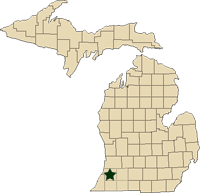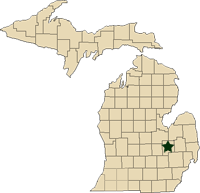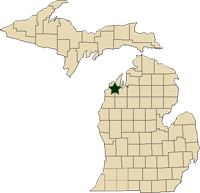Regional reports on Michigan fruit – June 26, 2012
MSU Extension educators’ pest and fruit updates for Michigan.
This week’s regional reports:
- Southwest Michigan - Mark Longstroth, Bill Shane, Diane Brown
- Southeast Michigan - Bob Tritten
- Northwest Michigan - Nikki Rothwell and Duke Elsner
Southwest Michigan – Mark Longstroth, Bill Shane, Diane Brown, Michigan State University Extension
|
Weather
Last week was warm with highs falling from the 90s into the 80s. Low temperatures varied quite a lot depending on the humidity – the low was around 50 for dry air and in the 60s for moist air. Rainfall was variable for the region. Storms moved through the area on Thursday (June 21), but generally left less than a tenth of an inch of rain. A cold front on Sunday (June 24) also did not bring rain.
Weather for this week is forecast to start cool and rise into the 80s to upper 90s. There is little chance of rain for the next two weeks. We have had about a half to two-thirds of our normal rain from March through June. Soils are becoming very dry and plants are shutting down to conserve water and showing signs of drought stress. Plants are using about an inch of water every five days, if it is available. The dry conditions are suppressing the emergence of some insect pests from the soil. Our growing degree day accumulations continue about two weeks ahead of an average year. Southern sites are only about five days ahead of northern sites in the region.
|
Southwest Michigan Growing Degree Day Totals from January 1 through June 24 | |||
|
Location |
GDD 42 |
GDD 45 |
GDD 50 |
|
1850 |
1578 |
1172 | |
|
1752 |
1482 |
1079 | |
|
Increase since 6/17/2012 |
228 |
206 |
171 |
Small fruit
Japanese beetles are increasing and should emerge in greater numbers following a good rain (about 0.25 inches). Spotted wing Drosophila flies are being trapped in the region. This pest can destroy a crop quickly before a grower knows he has it. Growers who are not trapping should not assume they do not have it, but should be preparing to protect against it.
Strawberry growers have begun renovation. They are mowing the leaf canopy, narrowing rows to 12 inches and applying fertilizers and herbicides. It is very important that growers apply adequate water to get the plants off to a good start. The dry conditions can stunt growth for a long time. Growers should also be prepared to treat against potato leafhoppers to avoid stunting new growth this season.
Bramble harvest continues. Jewel black raspberry and Nova red raspberry are being harvested. Some growers report delayed or poorly fruiting summer raspberry and blackberries apparently associated with spring freeze damaged canes. Growers should irrigate to maintain plant health and fruit growth. Bramble insect pests include raspberry sawflies, leafrollers and raspberry cane girdlers. With the hot, dry weather, growers should be on the lookout for spider mites. Japanese beetles can be a problem in raspberries at harvest. Consider applying control right after a picking to reduce beetle pressure. Hopper burn from potato leafhoppers is increasing.
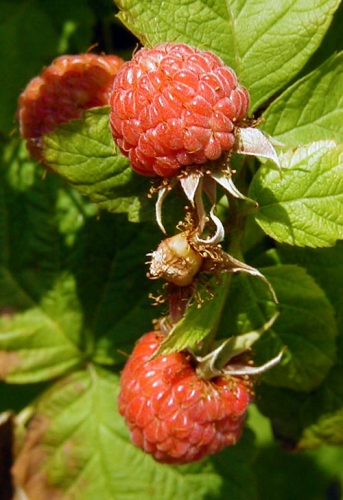
Ripe, red raspberries near Benton
Harbor, Mich.
Photo credit: Mark Longstroth, MSUE
In grapes, fruit on the primary shoots in juice grapes is reaching berry touch. Fruit on secondary shoots is at buckshot berries. Wine grape development is not quite as advanced, but it shows the same degree of developmental differences between primary (buckshot) and secondary shoots (berry shatter). Phomopsis and black rot are present in unsprayed vineyards, but dry weather has kept disease severity low. Powdery mildew is scarce, but the post-bloom period is important to prevent mildew on the fruit. No downy mildew has been detected.
Grape berry moth trap catches decreased last week. Initial biofix for grape berry moth in the southern Berrien County was May 18 and on May 21 in northern Berrien and Van Buren counties. The grape berry moth model on Enviro-weather predicts the second generation should begin about today (June 26) for locations in southern Berrien County. See the article on mid-season berry moth control.
Blueberry harvest has begun. Hand harvest of Duke and other early varieties is underway. Birds are a problem as fruit colors. Growers should be irrigating to maintain fruit. Growers who started their trickle irrigation late cannot keep up. Leaf burn and fruit shrivel from drought stress is reported in unirrigated and poorly irrigated fields. Cane collapse from phomopsis is beginning. Controls for anthracnose should be applied as the fruit reaches 10 percent blue in a field.
Blueberry maggot flies are being caught in commercial blueberry fields. Growers can expect this pest to emerge in good numbers after a rain. Spotted winged Drosophila flies are being trapped in Allegan, Ottawa and Van Buren counties. Growers should be monitoring for these pests. For more insect scouting information, see the Blueberry Insect Scouting Report for June 18-24, 2012.
Tree Fruit
Dry soils are causing wilting and yellowing and drop of older leaves of many fruit plants in sandy sites. Growers should irrigate plant material established this spring and perhaps last year. Growers with well-established plantings and no fruit can reduce irrigation in tree fruits to reduce growth. Irrigation can be reduced by a third or more, but not cut off completely. San Jose scale crawlers have settled and are becoming protected from insecticides by the scale covering. Trap catches for most moth pests decreased last week.
Peach fruit are 2 inches or more in diameter and the pits are hardening. Growth is abundant in sites with little or no crop, adequate water and fertilizer. Peaches in sandy sites are beginning to yellow, indicating the growers did not apply the second half of their split application of nitrogen due to the lack of crop. If makes no sense to apply fertilizer under these dry conditions and have the fertilizers sit on the ground waiting for a rain. Harvest of very early varieties such as PF1, PF5D Big and Earlystar is underway this week in the southern end of the district.
Rusty spot (powdery mildew) susceptibility stops with pit hardening. Fruit symptom from rusty spot is relatively severe this year. Bacterial spot susceptibility of fruit also declines with pit hardening – this disease is relatively mild this year due to the recent lack of rain. X-disease symptoms are becoming apparent. Trees infected with X-disease should be removed. Oriental fruit moth trap catches has increased and we estimate that the second generation moth flight of this pest is beginning now. Trunk sprays for peach tree borer are generally applied in late June to early July, but may need to be done earlier or after harvest to avoid problems with days to harvest restrictions for Lorsban.
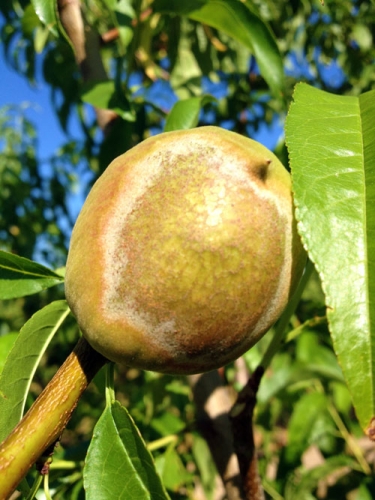
Rust spot in peach is very severe
this year.
Photo credit: Bill Shane, MSUE
Tart cherry harvest has ended. Large flocks of birds have caused losses in tart cherry orchards with fruit. Growers who harvested fruit estimate they lost 50 percent of the crop to either birds or raccoons. Due to the dry conditions, cherry leaf spot is not a serious problem.
Japanese plums are about 1 inch in diameter. Flowers and fruit of European plum varieties was hit harder by the spring freezes than Japanese types, which are generally grown in better, frost-free sites due to their early bloom.
Apple fruits are generally 1.5 to 1.75 inches in diameter, with summer apple varieties such as Zestar much larger at 2.5 inches or more. Redbanded leafroller trap catches are still high in the second generation of this pest. Codling moth biofix was set as May 7 and moth flight of this generation should be declining, but may overlap with the start of the second generation flight, which is estimated to begin by the end of June. Obliquebanded leafroller biofix was May 19 and we are past peak egg hatch. Scout for larvae feeding in terminals.
Oriental fruit moth second generation moth flight was estimated to begin the second week of June in Berrien County. European red mite populations should be monitored and the treatment threshold is five mites per leaf. Mature trees without fruit can probably withstand high levels of mite infestation with little damage. The first apple maggot flies have been trapped, which is generally followed in eight to 10 days by egglaying. Powdery mildew symptoms are common and growers should control this disease to prevent loss of fruit buds in the winter. Green apple aphids can be seen in some sites. Leaf symptoms due to the spotted tentiform leafminer sap-feeding stage should be showing up over the next week.
Pear fruit are about an inch in diameter on Harrow Sweet. Pear psylla is present in low numbers.
Southeast Michigan – Bob Tritten, Michigan State University Extension
|
Weather
Our dry soils across the region have been the major story for the last few weeks; most fruit growers are applying irrigation to both new and established plantings. Where tree fruit growers do not have a crop, they are not as concerned on established plantings. We’ve received two to three wetting events in the last week; most fruit farms received only a few hundredths of an inch of rainfall, not enough to settle the dust, let alone to overcome our moisture deficit. Hail was reported by a few fruit growers in these fast moving thunderstorms.
Our early, warm season is still running two weeks ahead of normal in terms of growth stages, and even more than that in terms of degree day totals.
|
East Michigan Growing Degree Day Totals for March 1 to June 25 | |||
|
Location |
GDD42 |
GDD45 |
GDD50 |
|
1725 |
1455 |
1050 | |
|
1703 |
1439 |
1043 | |
|
Flint (Genesee) |
1764 |
1491 |
1089 |
|
1751 |
1485 |
1087 | |
|
1852 |
1575 |
1158 | |
|
1640 |
1380 |
997 | |
|
1771 |
1501 |
1092 | |
Tree fruits
Apples are just over 1.5 inches in diameter where growers have a crop. Growers with crops (mostly in the very southern tier of Michigan counties) are wrapping up hand-thinning. Growers are bending limbs in high density blocks to promote flower bud development for next year’s crop. Growers are finding a fair amount of frost rings and scaring from freeze damage. More apples continue to show up in these areas. Most apple trees have between 15 and 20 inches of new growth, with some terminals reaching 28 inches of new growth.
Potato leafhopper leaf curling has become very common in the last two weeks where growers have not applied an insecticide in the last five to six weeks. In most unsprayed apple blocks, almost every leaf is curled from this insect. I recommend that this pest be controlled in young apple blocks and in valuable varieties, like Honeycrisp. Insect pressure remains low.
Codling moth trap catch numbers are on the decline for the third week as we are nearing an end to first generation adult flight. We had four weeks of record-breaking numbers of codling moths caught in traps this season, even in mating disrupted blocks. Where growers have an apple crop this season, the second generation adult flight will need to be closely monitored and controlled. European red mite numbers are being kept in check by predators at most farms. I have not caught any apple maggot in traps this season; I feel that the dry soils may be contributing to lack of trap catch, as we should be seeing them already.
Powdery mildew-infected terminal branches and individual leaves have become much more evident in the past few weeks; some varieties are heavily infected and some terminal limbs are starting to die from this disease. I am encouraging apple growers to keep a close eye on powdery mildew infections in valuable and susceptible varieties, even in blocks with no fruit. Some growers without a crop are considering sulfur applications to help control it. It is hard on foliage, however. Sooty blotch and fly speck symptoms continue to be seen in light amounts.
Pear suckers have put on a tremendous amount of growth this season, some reaching 5 feet in length. Pear psylla populations continue to grow quickly in unsprayed blocks. Suckers need to be removed to help reduce pear psylla populations.
Peach leaves where there is no crop are looking more normal in size, color and volume, with most of the freeze-injured leaves now dropping to the orchard floor. Harvest is expected to begin for the earliest of peach varieties in the next few days. As expected, there is a fair amount of split pit in these early varieties.
Sweet cherry growers with a crop found a fair amount of cherry fruit fly -infected fruit toward the end of harvest, with some farms seeing 25 percent of their fruit infected. A post-harvest insecticide application is needed in these blocks with a history of this pest. I am seeing very little cherry leaf spot disease in most blocks. Bird feeding was a major challenge this season.
Tart cherry harvest is underway at most farms where there is a crop. Bird feeding is a major challenge. Growers need to be on the lookout for cherry fruit fly-infested fruit.
Plums will be very hard to find this season, as most blocks have little to no viable fruit.
Small fruits
Strawberry harvest is wrapping up at almost all farms, with the few that remain open finishing in the next few days. Renovation should begin as soon as possible. Potato leafhopper leaf cupping and leaf margin burning has become common in the last few days in new plantings. Fields need to be scouted immediately for this insect and damage. Root weevils have been found at a few more farms in the last week. Sap beetle and thrip feeding damage has been reported at a few more farms as well in the last week.
Raspberry harvest continues on summer fruiting varieties. At most farms, summer bearing raspberries had a great deal of tip burn or dieback from the April freeze events. At these farms, harvest will be less than 10 percent of normal years. Canes of fall bearing types have 18 to 24 inches of new growth. Potato leafhopper feeding injury has caused extensive leaf cupping in many fall raspberry plantings in the last week. Fields need to be scouted immediately for this insect and damage.
Japanese beetles were found for the first time this season last Friday (June 22) in a few fall raspberry plantings. Growers need to be the lookout for this pest. Raspberry cane borer flagging damage continues to be seen. Raspberry sawfly leaf feeding damage continues to be seen at a few farms. Remember to check spotted wing Drosophila traps at least twice a week. None have been found for the season in eastern Michigan, although they have been found in traps in west Michigan for the last four weeks.
Blueberries continue to color, with most being 14 mm in size. Harvest is expected to begin in the next week for early maturing varieties. Leaf growth is much improved in freeze damaged varieties. It is odd to see all of the fruit exposed as it has been thus far this season. Some of this fruit on the effected varieties will most likely not mature correctly. No blueberry maggots have been caught in traps, although they are being caught in traps in west Michigan. Remember to check spotted wing Drosophila traps.
Grape berry size is extremely variable this season due to freeze damage. The largest berries from the primary shoots are at pea size, and most of the secondary berry clusters are just finishing bloom to buckshot in size. Many of the fruit clusters are not filled out very well. Grape berry moth trap remains low, but I expect it to rise in the next few weeks.
Northwest Michigan – Nikki Rothwell and Duke Elsner, Michigan State University Extension
|
Weather
Recent temperatures in northwest Michigan have been extremely pleasant following hot and humid days on June 19-20 that reached into the high 80s and low 90s. The last four days recorded daytime temperatures in the mid-70s and overnight temperatures in the mid-60s. Conditions continue to be windy, and Sunday (June 24) brought fairly high winds. Winds have been problematic for growers to plan cover sprays in the orchard. Thus far this season, we have accumulated 1,579 GDD base 42 and 956 GDD base 50. After the rain just over a week ago, conditions have been dry here in the north. Some MSU Enviro-weather stations recorded just a touch of rain on Sunday morning, but overall conditions have been dry.
Crop report
Sweet cherry harvest has begun across the region. With the light crop and high heat last week, growers have been modifying their ethephon rates to allow for easy removal of fruit, but also to prevent phytotoxicity. Overall fruit quality looks good. We have seen bacterial canker on fruit and some cracking with last week’s rain, but quality is still fairly high. Conditions have been dry and cool enough, so little American brown rot infection has been reported as we move into the harvest season. The tart cherry crop is extremely small, but a few growers are anticipating shaking isolated orchards or areas within orchards; however, we will actually harvest a minute portion of a typical yield for northwest Michigan. The apple crop continues to look good, and some growers are reporting 40 percent of a normal crop. Isolated hail hit the region late last week. Strawberry harvest is over in northwest Michigan.
Pest report
Cherries. Last week, tart cherry blocks had a tremendous amount of yellowing leaves, but with the recent winds, trees have lost those leaves. So, the trees “look” better than they did with the yellow leaves, but lots of leaves have been lost too early in the season. We scouted multiple orchards across the region last Friday (June 22), and cherry leaf spot is not hard to find in any orchards. However, some orchards have better cherry leaf spot control than others – we are in the process of trying to understand the different levels of control. We welcome input as we tackle this difficult issue.
Again, we encourage growers to scout the orchard as a cherry leaf spot infection this early in the season can result in early defoliation and set trees up for damage as we head into winter. We did find a few orchards with a severe bacterial canker infection, and this disease was the primary cause of defoliation. Even if canker was the original culprit, cherry leaf spot control is even more important on the leaves that are remaining on the tree. We are recommending that growers use full covers if their cherry leaf spot infection is high or if they have already lost lots of leaves this season. If dry weather continues, an alternate row strategy could work only if cherry leaf spot is under control at this time; this strategy could be problematic as there is a lot of inoculum in orchards throughout the region, even if a particular block looks good. Growers should remember that although the season seems long, we are still in June and have a considerable amount of time to protect those leaves into later summer and early fall. (For more information, please see the article Cherry leaf spot: Save the leaves!).
If growers are using the 24(c) with Bravo Weather Stik, applications will need to be discontinued 21 days prior to harvest. Powdery mildew is evident in most tart cherry orchards, and once the white mycelium is on the leaf, control options will only further protect new foliage; we do not have any products that will eradicate powdery mildew.
As growers move into sweet cherry harvest, American brown rot is the disease to watch. The dry weather in the last six days will minimize the growth of this pathogen, but there is considerable American brown rot showing up across the region. We should be particularly careful if conditions change and become conducive for American brown rot (wet and warm); this disease can take out an orchard’s production in a short amount of time. Additionally, bacterial canker on fruit, small cracks and bird pecks will increase the potential for American brown rot to get established in an orchard. Growers should take the time to scout their orchards for American brown rot. If the orchard has this disease present, it should not be difficult to locate fruit with the typical, gray-brown fungus on the fruit. Blocks with bacterial canker, bird damage, or problematic orchards should be the first stop in scouting.
If American brown rot is detected, growers should move to an every row spray regime for fungicide applications, particularly if the trees are large. Growers should also slow down the tractor speed to obtain adequate coverage. Efforts should be made to apply fungicide applications with ample water to ensure that the entire tree is properly covered. Controlling obliquebanded leafroller is also of utmost importance as we approach harvest. These larvae web cherry clusters together and prevent fungicide penetration inside the cluster. If growers know that they have had a problem in the past with obliquebanded leafrollers and did not control them at the overwintering generation timing, they will decidedly need to apply an insecticide for the summer generation as these insects could ultimately impact American brown rot control at or near harvest. The sterol inhibitors (SI) remain the optimal choice for American brown rot control, and Indar has routinely provided the best control of that class of chemistries.
Obliquebanded leafroller trap counts are up this week with an average of 27 moths per trap. These insects are mating and females are laying eggs at this time. Depending on when certain blocks of sweet (and tart) cherries will be harvested, obliquebanded leafroller larvae could be present at the time of harvest. In the past three years, this insect has become a contaminant pest in tanks of harvested fruit. To ensure these insects are not in the tank at harvest, growers will need to apply an effective material that specifically targets Lepidoptera. Additionally, growers will need to be aware of the pre-harvest intervals (PHI) as they approach the harvest window.
We have three new Lepidopteran materials that work well against obliquebanded leafroller: Delegate (seven-day PHI), Belt (seven-day PHI), and Altacor (10-day PHI), and all three materials provide excellent control of obliquebanded leafrollers. Bts, such as Entrust, will work against obliquebanded leafrollers, but will be slower acting than the other materials. Sevin and the pyrethroids have a three-day PHI, but older data tell us that these chemistries will not be effective due to cross resistance with the Ops.
Other insects are present in cherry blocks. Plum curculio are still evident in the orchard and with the limited amount of fruit, they are competing for egglaying sites. We have also caught cherry fruit flies again this week, and numbers have gone up compared to last week. Growers should be applying an insecticide to control cherry fruit flies as we head into the harvest season to prevent larvae in the fruit at harvest. As each cherry fruit fly population is unique to individual farms, growers should be monitoring for these insects with a yellow sticky trap baited with ammonium acetate. Female flies begin to deposit eggs in the fruit seven to 10 days after they emerge, and as soon as larvae hatch, they burrow into the ripening fruit to feed. Neonicitinoids, such as Provado or the generics, are rated as good against cherry fruit flies, but only last for about seven days in the orchard. If the harvest window is stretched, a new application of this product is warranted. Organophosphates (Guthion and Imidan) last longer, but Guthion’s PHI is 15 days and Imidan’s PHI is seven days. Imidan cannot be used in sweet cherries.
Sap beetles have been found in ripening sweet cherries. These insects overwinter as adults in protected places such as decaying vegetation, debris or fruit buried in the ground. In the spring, adults come out of hibernation and mate. Egglaying begins in May and June and females lay near decomposing plant material. Larvae develop in food material in contact with the soil and full-grown larvae leave their food when mature, wander through the soil and molt into the pupal stage. Adults emerge in June and July and there is usually only one generation per year.
Sap beetles can be a problem in cherries if branches are low hanging and the fruit comes in contact with the ground or tall grass in the row middles. However, we first had high populations of sap beetles in 2010 where these insects were problematic even on trees with branches pruned up high – since that time, we have observed these insects more consistently in cherry orchards across the northwest. This pest may be one that needs to be controlled annually.
Growers should be on the lookout for sap beetles in fruit that is ripening or damaged as they are attracted to ripe or overly ripe fruit. Control of these insects will likely be difficult as the adult beetles burrow into fruit to feed. Additionally, we are at or approaching harvest, so growers will need to pay special attention to the PHIs of the materials. Pyrethroids have good knockdown and short PHIs, Sevin and malation also have three--day PHIs. Danitol has been reported to be effective against sap beetles by area scouts.
We caught an average of 19 lesser peach tree borer this week and an average of four peach tree borers. Borers still need to be controlled even if there is no fruit in a block.
Apples. No apple scab infection periods were reported since June 18. Based on the March 20 biofix (McIntosh green tip), we have called an end to primary scab. If growers were not able to control scab in this primary season, they need to keep fruit protected from this pathogen as we move through the season. Growers should be aware of the 77-day PHI for the EBDCs as we are approaching that date, depending on variety and time of harvest. Growers should also note that strobilurin resistance has been confirmed in all major apple growing regions of the state and the mutation confers complete resistance – fungicides containing strobilurin will not work against apple scab and increasing the rate of a strobilurin is not an effective option.
Powdery mildew is evident in area orchards, and other areas of the state are reporting sever powdery mildew infections. Unfortunately, fire blight strikes are evident in all blocks across the region. We hypothesize that these infections were the result of tag bloom or the long lasting bloom in apples coupled with the right weather conditions. We are currently testing for streptomycin resistance in the fire blight bacteria in all counties in northwest Michigan.
Codling moth trap counts are still very low here at the Northwest Michigan Horticultural Research Center (NWMHRC). However, scouts are reporting very high trap counts in commercial blocks in northwest Michigan. We recommend that growers monitor for this pest in their own orchards as there is variability in the pest population from block to block; the degree day accumulation is highly dependent on the biofix date (the first date of sustained codling moth trap catch) for each apple block. Growers should track the progress on their farms using the MSU Enviro-weather codling moth model and on-farm trap catch data.
Obliquebanded leafroller numbers remain constant in apples and we caught an average of 15 moths per trap this week. The summer generation larvae will begin showing up in regional orchards in the coming weeks and fruit should remain protected from these hatching larvae. Rose chafers are still evident in area orchards, but the populations are markedly down from last week.
Armyworms, an unusual pest of tree fruit, have been observed feeding on apples in regional orchards. This insect is native to North America and their name comes from their behavior of moving across fields in an army-like fashion. As larvae (Photo 1) consume available food sources, they migrate as an army to new host plants. They feed primarily on grasses (oats, wheat, fall rye, corn, barley and forage grasses), and they have devastated sod centers in some orchards in the region.
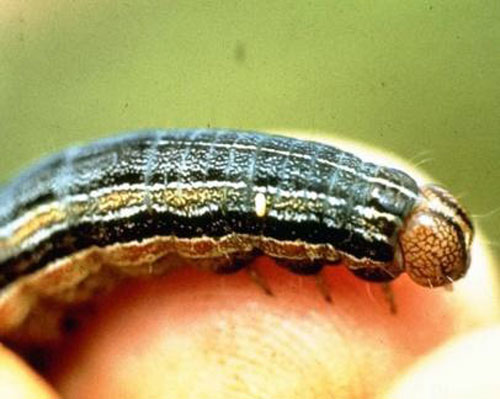
Photo 1.
Armyworm larva in Leelanau County.
Photo credit: Matt Montgomery, Univ. of
Illinois Exntension
Although this insect has caused feeding damage to apples (Photo 2), the larvae are difficult to find at this time. The feeding is a large hole that is 0.25 inches deep and may be confused with rose chafer feeding. However, rose chafer damage is much more superficial than these deeper feeding holes left by the armyworm. We believe that the population was high over the past week or so, but has rapidly declined as a result of virus and potentially parasitic flies. Unless populations are still high at this time, growers should not need to treat for this insect.
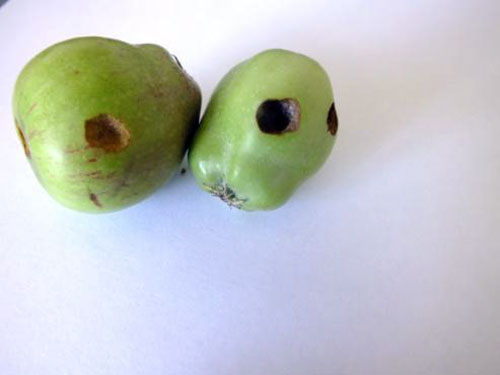
Photo 2. Army
feeding damage in apples.
Grapes. Very nice weather during bloom has resulted in a good looking berry set in the area.
Rose chafers numbers have dropped off to minimal levels and their damage was of no concern in most sites. Potato leafhopper adults and nymphs are very plentiful in the area. Many vineyards are showing leaf deformity and shortened internodes. Three-banded leafhoppers and related stippling leafhoppers are now quite numerous on wild vines in the edges of woodlots; these will rarely move into commercial vineyards, and if they do, their injury is typically not important.
The first foliar galls of grape phylloxera are developing on susceptible cultivars.
Whiteflies were found on a few vines this week. This is the first time we have seen these on vines in northwest Michigan, so we know very little about their potential to injure grapevines.
Powdery mildew is still very hard to find in the area. Even if scouting reveals no infections at the moment, it is advisable to keep vines protected during this time to protect the newly set berries.
Saskatoons. Some fruit has reached maturity and harvest is probably underway in the more advanced sites. Bird depredation is underway – cedar waxwings seem to be particularly fond of fruit in near Northport, Mich. Rose chafer injury has essentially ended. Potato leafhoppers are fairly plentiful, but their injury seems to be minimal to saskatoons. A few egglaying scars of plum curculio have been seen on fruits. The main disease problem seen this week has been rust disease on fruits and stems.



 Print
Print Email
Email